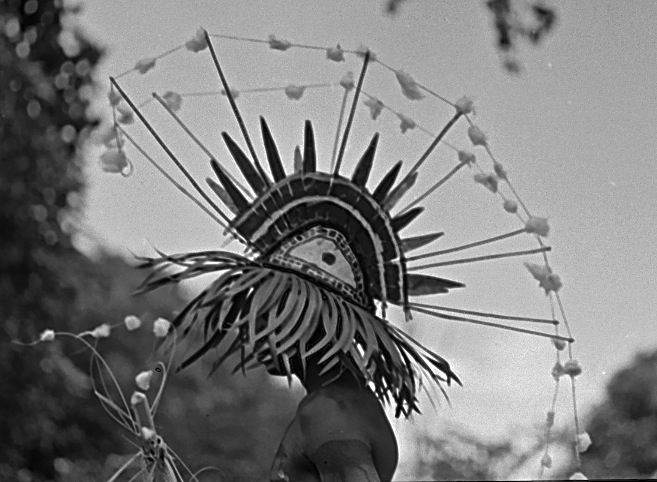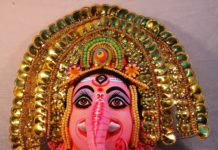
Mask making is regulated and protected by numerous traditional taboos and levels of secrecy. The latter restrictions are still part of normal life in Vanuatu and need to be respected, not only by ni-Vanuatu, but also by foreign scholars, academics, and dealers in “arts and crafts”—not only in print but also particularly now online. To respect these prohibitions, only a general outline of the topic will be dealt with below.
 The making of masks, headdress masks and ritual headgear in Vanuatu is, in general, an extremely intense and sometimes dangerous religious activity involving the preparation of temporary material points of appearance or entry of ancestral and other spirits from their worlds into the present-day material world. Mask production is almost exclusively an initiated male activity done in seclusion in a special sacred area in the bush, far away from the gaze of women and non-initiates. This is not just to enable the necessary atmosphere for such spiritual creation processes, but also to protect women and non-initiates from powers that may harm them. The maker must usually follow strict dietary and other restrictions during this process: he must essentially be in a type of “state of grace” to ensure successful creation.
The making of masks, headdress masks and ritual headgear in Vanuatu is, in general, an extremely intense and sometimes dangerous religious activity involving the preparation of temporary material points of appearance or entry of ancestral and other spirits from their worlds into the present-day material world. Mask production is almost exclusively an initiated male activity done in seclusion in a special sacred area in the bush, far away from the gaze of women and non-initiates. This is not just to enable the necessary atmosphere for such spiritual creation processes, but also to protect women and non-initiates from powers that may harm them. The maker must usually follow strict dietary and other restrictions during this process: he must essentially be in a type of “state of grace” to ensure successful creation.
From the northern part of the island of Epi northwards as far as the Torres Islands, approximately 80 language groups produced, or still produce, hundreds (or potentially even thousands) of different forms of masks for ritual purposes. Depending upon the culture, many of these masks, particularly the most fragile ones, are destroyed or left to rot after ritual display and use. The materials can be of leaf and floral materials, wood, treefern, or can, in certain areas, be formed on a base of the former covered in a vegetable fibre paste the exact nature of which is extremely secret. Colours are usually of vegetable and mineral origin. The central and southern islands do not produce masks.
Although there are specialists in the production of these materialized spirit forms, a number of cultures—particularly those using the vegetable fibre paste over-modellage techniques—theoretically might permit any correct initiated male who has paid the copyright price in tusker pigs, shell money and respect, to produce them. Individuals producing them without the traditional rights are subject to strict fines and possibly escalating levels of punishment. This is normal in cultures where such ritual material is essential for perpetuating the links between the material and non-material worlds and, with tusker pig sacrifice, essential also for the continuation of life itself.
Within Vanuatu, examples of some of these stunning masks are on display in the National Museum of the Vanuatu Cultural Centre in the capital, Port Vila, and at the Malakula Cultural Centre in Lakatoro on the island of Malakula. “Living and moving” examples can be seen periodically during normal traditional rituals, particularly on Malakula, Ambrym and on some of the Banks Islands. They also appear at the island and national arts festivals, organized regularly since 1979 to promote traditional culture and identity, not tourism.
This brief article is dedicated to the memory of my late customary father Chief Richard Leona, Boevudalua Tungoro Vanuatu, who passed away at home in Loltong, north Pentecost, on 6th December 2015.
Further reading
Bonnemaison, J., K. Huffman, C. Kaufmann, D. Tryon (eds), Arts of Vanuatu, Bathurst (NSW) and Honolulu, Crawford House Press/University of Hawai’i Press, 1996.
Guiart, J., Océanie, Paris, Gallimard, 1963.
Guiart, J., Mondes et Cultures: Nouvelles-Hébrides, Auvers-sur-Oise, Archée Éditeur, 1965.
Guiart, J., ‘Art as a Means of Communication in Pre-Literate Societies’, in Eban, D. et al (eds), Procedings of the Wright International Symposium on Primitive and Precolumbian Art[1985], Jerusalem, 1990, pp. 217 – 243.
Howarth, C., Kastom: Art of Vanuatu, Canberra, National Gallery of Australia, 2013.
Huffman, K., ‘Masks, ‘headresses’ and ‘ritual hats’ in northern Vanuatu’, in Bonnemaison et al, 1996, pp. 19 – 25.
Huffman, K., Traditional ‘Arts’ in Vanuatu, Artok: Pacific Arts Online (Australian Broadcasting Corporation), 17th October 2000,
Huffman, K., ‘Pigs, Prestige and Copyright in the Western Pacific’, Explore, Australian Museum, Sydney, vol. 29, no. 6, December 2007, pp. 22 – 25.
Huffman, K., ‘Sacred Pigs to Picasso’: Vanuatu art in the traditional and ‘modern’ worlds’, Art & Australia, vol. 46, no. 3, 2009, pp. 472 – 479.
Speiser, F., Ethnology of Vanuatu: An Early Twentieth Century Study, Bathurst (NSW), Crawford House Press, 1991 (translated from 1923 German original).
Vienne, B., ‘Masked Faces from the Country of the Dead’, in Bonnemaison et al, 1996, pp. 234 – 237, 240 – 246.



